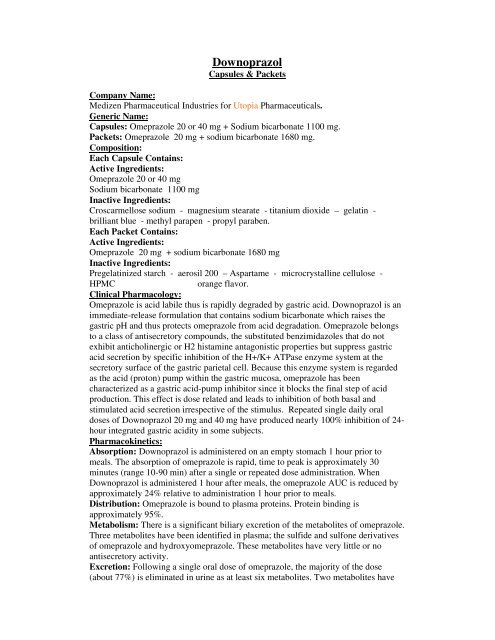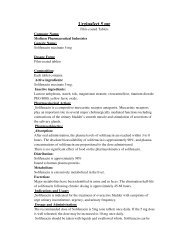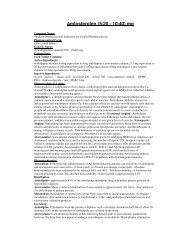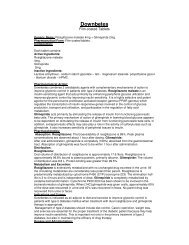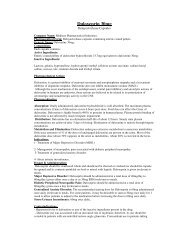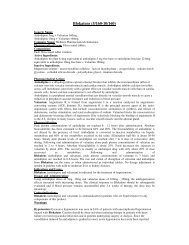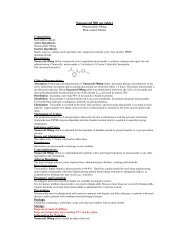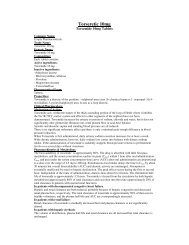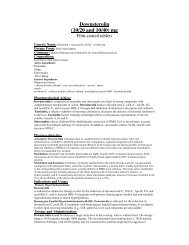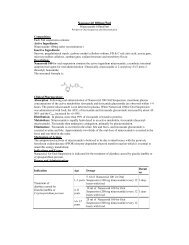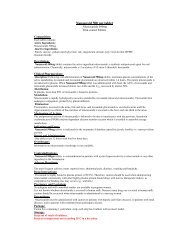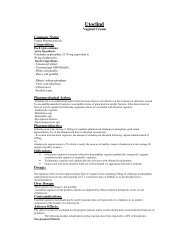Downoprazol - Utopia Pharmaceuticals
Downoprazol - Utopia Pharmaceuticals
Downoprazol - Utopia Pharmaceuticals
You also want an ePaper? Increase the reach of your titles
YUMPU automatically turns print PDFs into web optimized ePapers that Google loves.
<strong>Downoprazol</strong><br />
Capsules & Packets<br />
Company Name:<br />
Medizen Pharmaceutical Industries for <strong>Utopia</strong> <strong>Pharmaceuticals</strong>.<br />
Generic Name:<br />
Capsules: Omeprazole 20 or 40 mg + Sodium bicarbonate 1100 mg.<br />
Packets: Omeprazole 20 mg + sodium bicarbonate 1680 mg.<br />
Composition:<br />
Each Capsule Contains:<br />
Active Ingredients:<br />
Omeprazole 20 or 40 mg<br />
Sodium bicarbonate 1100 mg<br />
Inactive Ingredients:<br />
Croscarmellose sodium - magnesium stearate - titanium dioxide – gelatin -<br />
brilliant blue - methyl parapen - propyl paraben.<br />
Each Packet Contains:<br />
Active Ingredients:<br />
Omeprazole 20 mg + sodium bicarbonate 1680 mg<br />
Inactive Ingredients:<br />
Pregelatinized starch - aerosil 200 – Aspartame - microcrystalline cellulose -<br />
HPMC orange flavor.<br />
Clinical Pharmacology:<br />
Omeprazole is acid labile thus is rapidly degraded by gastric acid. <strong>Downoprazol</strong> is an<br />
immediate-release formulation that contains sodium bicarbonate which raises the<br />
gastric pH and thus protects omeprazole from acid degradation. Omeprazole belongs<br />
to a class of antisecretory compounds, the substituted benzimidazoles that do not<br />
exhibit anticholinergic or H2 histamine antagonistic properties but suppress gastric<br />
acid secretion by specific inhibition of the H+/K+ ATPase enzyme system at the<br />
secretory surface of the gastric parietal cell. Because this enzyme system is regarded<br />
as the acid (proton) pump within the gastric mucosa, omeprazole has been<br />
characterized as a gastric acid-pump inhibitor since it blocks the final step of acid<br />
production. This effect is dose related and leads to inhibition of both basal and<br />
stimulated acid secretion irrespective of the stimulus. Repeated single daily oral<br />
doses of <strong>Downoprazol</strong> 20 mg and 40 mg have produced nearly 100% inhibition of 24hour<br />
integrated gastric acidity in some subjects.<br />
Pharmacokinetics:<br />
Absorption: <strong>Downoprazol</strong> is administered on an empty stomach 1 hour prior to<br />
meals. The absorption of omeprazole is rapid, time to peak is approximately 30<br />
minutes (range 10-90 min) after a single or repeated dose administration. When<br />
<strong>Downoprazol</strong> is administered 1 hour after meals, the omeprazole AUC is reduced by<br />
approximately 24% relative to administration 1 hour prior to meals.<br />
Distribution: Omeprazole is bound to plasma proteins. Protein binding is<br />
approximately 95%.<br />
Metabolism: There is a significant biliary excretion of the metabolites of omeprazole.<br />
Three metabolites have been identified in plasma; the sulfide and sulfone derivatives<br />
of omeprazole and hydroxyomeprazole. These metabolites have very little or no<br />
antisecretory activity.<br />
Excretion: Following a single oral dose of omeprazole, the majority of the dose<br />
(about 77%) is eliminated in urine as at least six metabolites. Two metabolites have
een identified as hydroxyomeprazole and the corresponding carboxylic acid. The<br />
remainder of the dose was recoverable in feces. Little, if any, of the unchanged drug is<br />
excreted in urine. The mean plasma omeprazole half-life in healthy subjects is<br />
approximately 1 hour.<br />
Indications and Usage:<br />
-Duodenal Ulcer: <strong>Downoprazol</strong> is indicated for the short-term treatment of active<br />
duodenal ulcer. Most patients heal within four weeks. Some patients may require an<br />
additional four weeks of therapy.<br />
-Gastric Ulcer: <strong>Downoprazol</strong> is indicated for the short-term treatment (4-8 weeks) of<br />
active benign gastric ulcer.<br />
-Treatment of Gastro esophageal Reflux Disease (GERD): <strong>Downoprazol</strong> is indicated<br />
for the treatment of heartburn and other symptoms associated with GERD.<br />
-Erosive Esophagitis: <strong>Downoprazol</strong> is indicated for the short-term treatment (4-8<br />
weeks) of erosive esophagitis which has been diagnosed by endoscopy.<br />
The efficacy of <strong>Downoprazol</strong> used for longer than 8 weeks in these patients has not<br />
been established. In the rare instance of a patient not responding to 8 weeks of<br />
treatment, it may be helpful to give up to an additional 4 weeks of treatment. If there<br />
is recurrence of erosive esophagitis or GERD symptoms e.g. heartburn, additional 4-8<br />
week courses of omeprazole may be considered.<br />
-Maintenance of Healing of Erosive Esophagitis: <strong>Downoprazol</strong> is indicated to<br />
maintain healing of erosive esophagitis.<br />
Dosage and Administration:<br />
<strong>Downoprazol</strong> should be taken on an empty stomach at least one hour before a meal.<br />
Recommended Doses of <strong>Downoprazol</strong> by Indication for Adults 18 Years and Older<br />
are as follows:<br />
Indication<br />
Short-Term Treatment of Active<br />
Duodenal Ulcer<br />
Recommended<br />
Dose<br />
20 mg<br />
Benign Gastric Ulcer 40 mg<br />
Symptomatic GERD<br />
(with no esophageal<br />
erosions)<br />
20 mg<br />
Erosive Esophagitis 20 mg<br />
Maintenance of Healing of Erosive<br />
Esophagitis<br />
Frequency<br />
Once daily for<br />
4 weeks<br />
Once daily for<br />
4-8 weeks<br />
Once daily for up to4<br />
weeks<br />
Once daily for up to<br />
4-8 weeks<br />
20 mg Once daily<br />
Administration of Capsules:<br />
<strong>Downoprazol</strong> Capsules should be swallowed intact with water. Do not use other<br />
liquids. Do not open capsule and sprinkle the content on food.<br />
Preparation and Administration of Suspension:<br />
Directions for use: Empty packet contents into a small cup containing 1-2 tablespoons<br />
of water. DO NOT USE OTHER LIQUIDS OR FOODS. Stir well and drink<br />
immediately. Refill cup with water and drink.<br />
If <strong>Downoprazol</strong> is to be administered through a nasogastric or orogastric tube, the
suspension should be constituted with approximately 20 mL of water. DO NOT USE<br />
OTHER LIQUIDS OR FOODS. Stir well and administer immediately. An<br />
appropriately-sized syringe should be used to instill the suspension in the tube. The<br />
suspension should be washed through the tube with 20 mL of water.<br />
Contraindications:<br />
<strong>Downoprazol</strong> is contraindicated in patients with known hypersensitivity to any<br />
components of the formulation.<br />
Adverse Reactions:<br />
Rarely: Fever, pain, fatigue, malaise, abdominal swelling, tachycardia, bradycardia,<br />
palpitation, pancreatitis, anorexia, irritable colon, dry mouth, stomatitis, marked<br />
elevations of liver function tests, muscle cramps, myalgia, muscle weakness,<br />
depression, hallucinations, confusion, insomnia, nervousness, tremors, somnolence,<br />
anxiety, vertigo, tinnitus, taste perversion and blurred vision.<br />
Drug Interactions:<br />
Omeprazole can prolong the elimination of diazepam, warfarin, phenytoin or other<br />
drugs that are metabolized by oxidation in the liver. There have been reports of<br />
increased prothrombin time in patients receiving proton pump inhibitors, including<br />
omeprazole, and warfarin concomitantly. Administration of omeprazole and<br />
atazanavir has been reported to reduce the plasma levels of atazanavir. Administration<br />
of omeprazole and tacrolimus may increase the serum levels of tacrolimus.<br />
Co-administration of omeprazole and clarithromycin have resulted in increases of<br />
plasma levels of omeprazole, clarithromycin and 14-hydroxy-clarithromycin.<br />
Pregnancy & Nursing Mothers:<br />
There are no adequate and well-controlled studies on the use of omeprazole in<br />
pregnant women. A decision should be taken to discontinue nursing or to discontinue<br />
the drug, taking into account the importance of the drug to the mother. In addition,<br />
sodium bicarbonate should be used with caution in nursing mothers.<br />
Precautions:<br />
Chronic use of sodium bicarbonate may lead to systemic alkalosis and increased<br />
sodium intake can produce edema and weight increase. Omeprazole concentrations<br />
have been measured in breast milk of a woman. Symptomatic response to therapy<br />
with omeprazole does not preclude the presence of gastric malignancy. The sodium<br />
content of <strong>Downoprazol</strong> products should be taken into consideration when<br />
administering to patients on a sodium restricted diet. Sodium bicarbonate is<br />
contraindicated in patients with metabolic alkalosis and hypocalcemia. Sodium<br />
bicarbonate should be used with caution in patients with Bartter's syndrome,<br />
hypokalemia, respiratory alkalosis, and problems with acid-base balance. Long-term<br />
administration of bicarbonate with calcium or milk can cause milk-alkali syndrome.<br />
Package:<br />
Carton box containing 7 packets + the insert leaflet.<br />
Carton box containing 1 (Pvdc/ Aluminum) strip of 14 capsules + the insert leaflet.<br />
Storage:<br />
Keep out of reach of children.<br />
Keep at a temperature below 30°C in a dry place.<br />
Instructions for Patients:<br />
- Keep this leaflet. You may need to read it again.<br />
- If you have any further questions, please refer to your doctor or pharmacist.<br />
- <strong>Downoprazol</strong> Capsules should be swallowed intact with water. Do not use other<br />
liquids. Do not open the capsule and sprinkle its content on food.<br />
- Directions on how to use packets: Empty packet contents into a small cup containing
1-2 tablespoons of water. DO NOT USE OTHER LIQUIDS OR FOODS. Stir well<br />
and drink immediately. Refill cup with water and drink.<br />
- If <strong>Downoprazol</strong> is to be administered through a nasogastric or orogastric tube, the<br />
suspension should be constituted with approximately 20 mL of water. DO NOT USE<br />
OTHER LIQUIDS OR FOODS. Stir well and administer immediately. An<br />
appropriately-sized syringe should be used to instill the suspension in the tube. The<br />
suspension should be washed through the tube with 20 mL of water.<br />
Produced by Medizen Pharmaceutical Industries for <strong>Utopia</strong> <strong>Pharmaceuticals</strong>.


